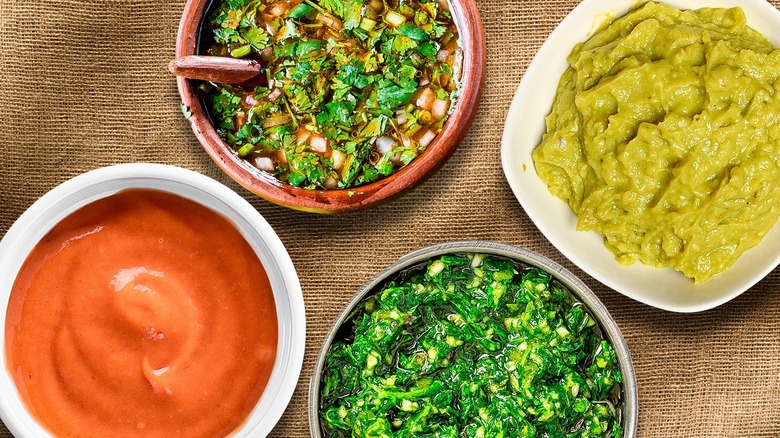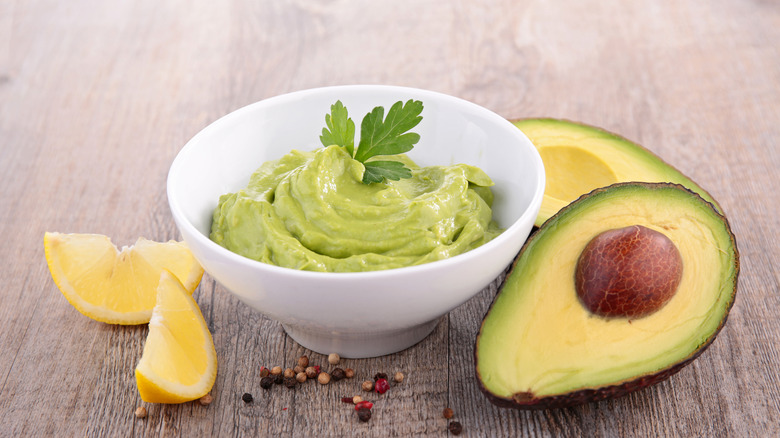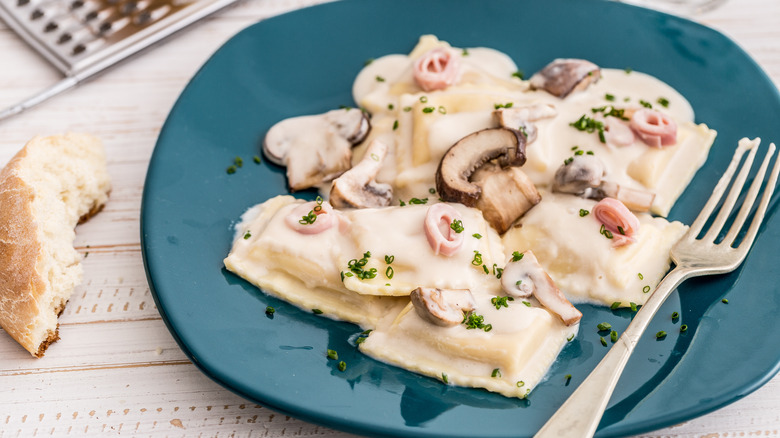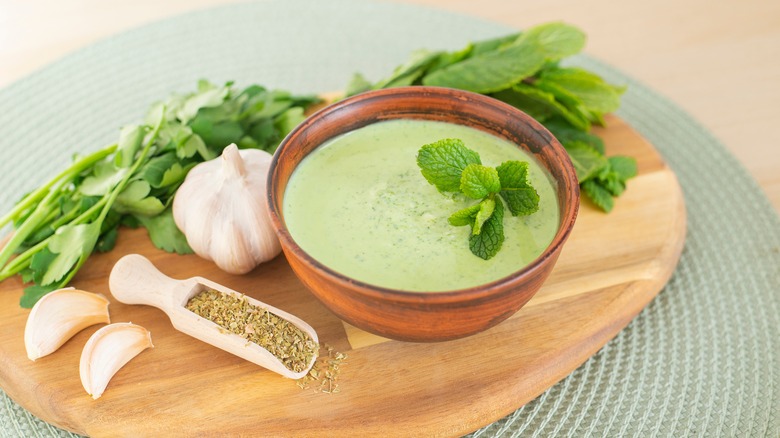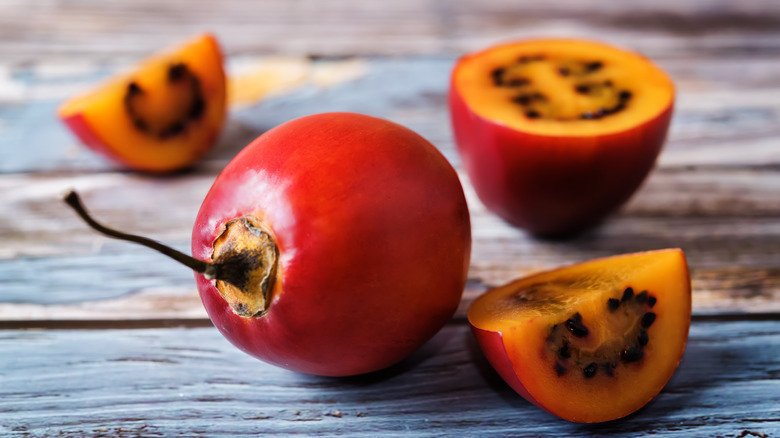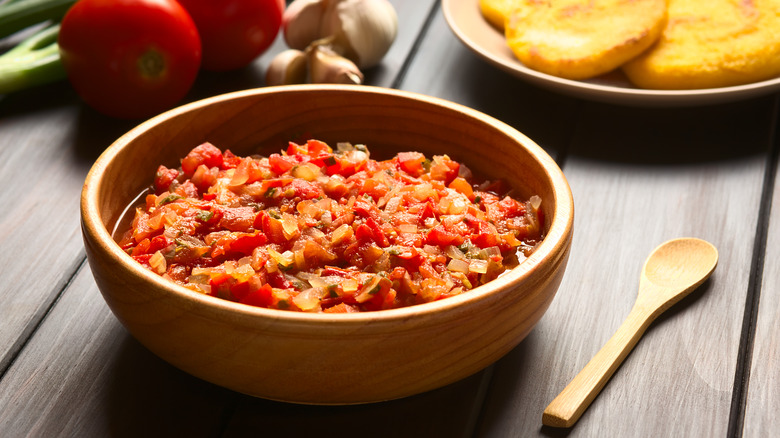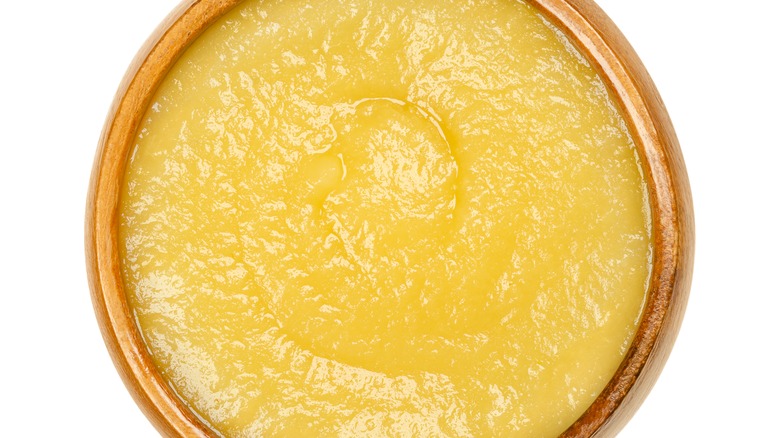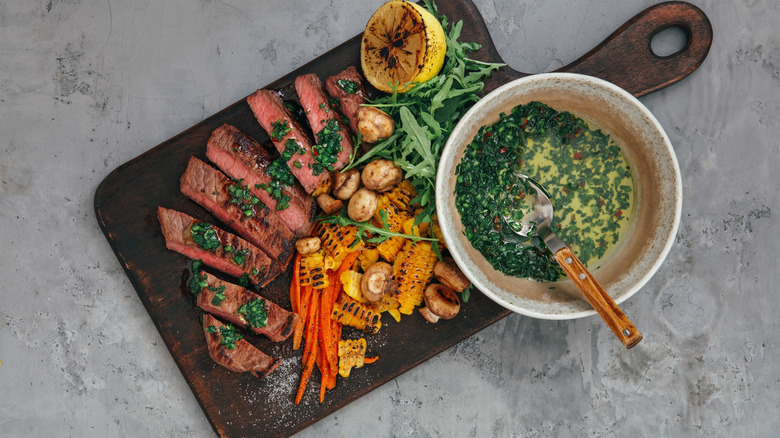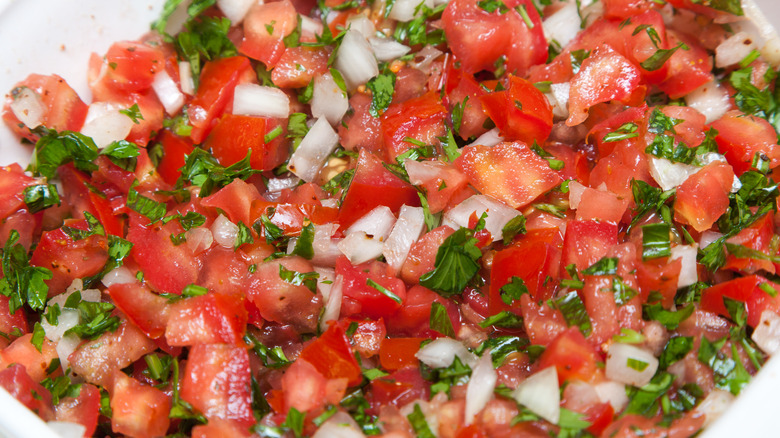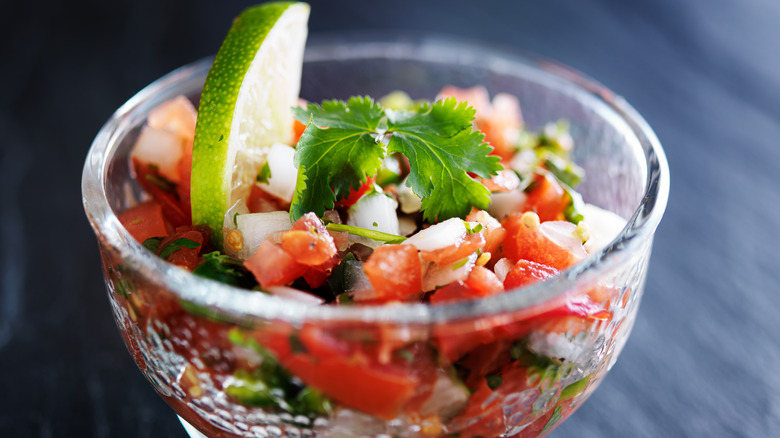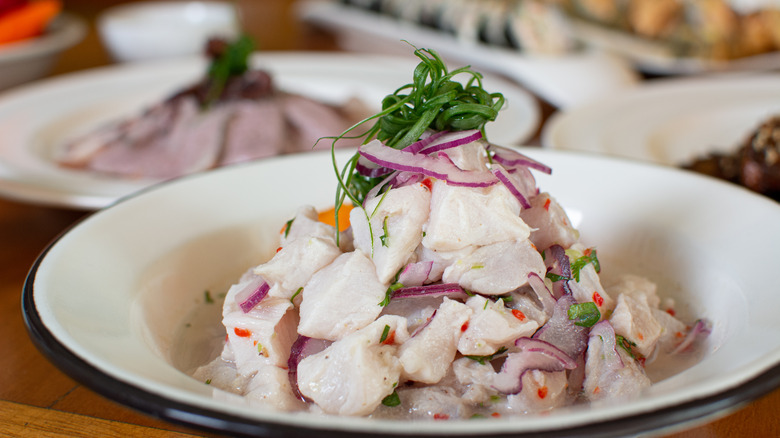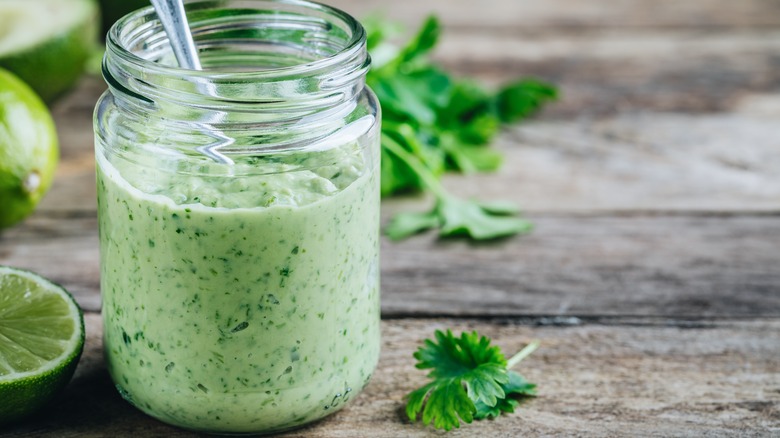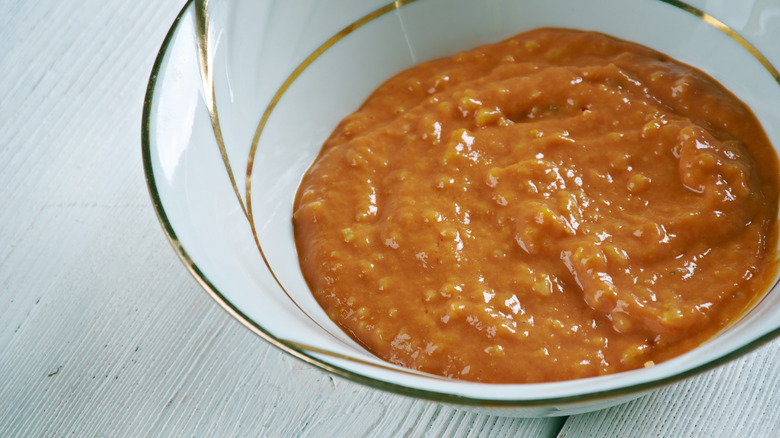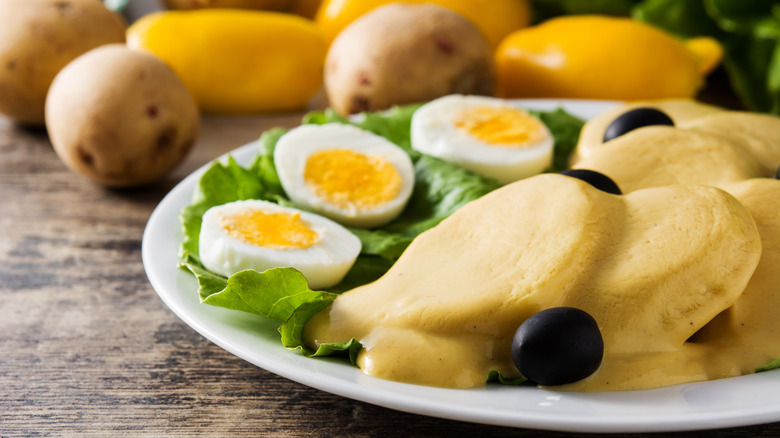14 Sauces From South America You Should Try At Least Once
South America is a melting pot bursting at the seams with fascinating history, vibrant culture, and mind-blowing food. There are myriad ingredients native to the continent that are difficult to find anywhere else, which leads to some truly unique recipes in each country — although there are many dishes whose rich traditions and history bleed across borders, with different cultures tacking on their own takes. There's plenty of protein to be found in countries like Brazil, Argentina, Paraguay, and the like, but some of the best recipes to emerge from South America are sauces.
South American sauces emphasize fresh ingredients native to their countries' respective regions, with herbs like cilantro and parsley and both hot and mild peppers playing a central role in many. Onions, garlic, olive oil, and vinegar are also common additions. Some sauces are easy to replicate at home with just a few ingredients, while others have a laundry list of unfamiliar ingredients and intimidating cooking techniques. But if there's a single constant among South American sauces, it's that each is jam-packed with dazzling flavors. Here are 14 absolutely brilliant South American sauces everyone should try at least once.
Guasacaca
If you like guacamole (who doesn't?), then you need to try guasacaca. Guasacaca is a Venezuelan sauce made with avocados, bell peppers, garlic, onions, olive oil, vinegar, and herbs like cilantro — though exact recipes may vary depending on what city, region, or family you're talking about. The inclusion of white, red wine, or apple cider vinegar gives guasacaca a unique briny tang that distinguishes it quite a bit from guacamole — guasacaca is also blended and emulsified versus hand-mashed, giving it a thinner consistency and lower viscosity than chunky guac.
Guasacaca can be used in a variety of ways. It's bright and tangy with a thin, creamy texture, making it a great pairing for any foods that pair well with herbs, avocado, and vinegar. Toss guasacaca with roasted veggies, use it as a salad dressing, drizzle it on top of arepas, or keep it simple and use it as a dip for chips or crudites.
Caruso
Even though it's found all over the world these days, pasta is most commonly linked with Italy. While yes, the boot-shaped country is the undisputed champ of pasta, and many famous recipes originated there, other countries have developed their own unique dishes and variations on pasta over the years. Uruguayan caruso sauce presents a great example. In the vein of Alfredo and bechamel sauces, caruso sauce is a thick, creamy, white pasta sauce that is likely traced back to an Italian chef, Raimondo Monti, who lived in Uruguay in the 20th century.
Caruso is made from roux, milk, melted cheeses, mushrooms, and ham. Chef Monti also included Bovril, a liquid beef broth, in his caruso for an even deeper, richer flavor — modern recipes often include beef bouillon cubes. Caruso is traditionally served with cappelletti, a pasta resembling tortellini stuffed with beef and cheese (caruso is not the best choice for lactose intolerants), but it can also be served with other types of pasta. The overall effect is a meaty, decadent sauce you need to try at least once.
Ají verde
Spicy sauce lovers, gather round — you need to know about ají verde. This aptly named electric green sauce (verde means green in Spanish, while ají refers to the type of peppers used in traditional recipes) is native to Peru and is used to jazz up anything you'd normally put hot sauce on. Ají verde is made by throwing hot ají peppers, fresh cilantro, garlic, lime juice, mayonnaise, and cotija cheese in a blender and pureeing until a smooth consistency is reached.
Sometimes, additional herbs are added, and occasionally, huacatay (black mint) is added to the mix. Ají peppers can be tough to track down in the United States, but don't worry; jalapeños make an acceptable substitute. Jalapeños can also be swapped in if you're hesitant about the spice level — even though mayonnaise cools things down a bit, this is still a truly spicy sauce. Ají verde harmonizes beautifully with grilled meat, fish, and poultry, is fantastic on tacos, and can be drizzled on top of empanadas or pupusas.
Tamarillo ají
Also called tree tomato or tomate de arbol, tamarillos are tart, juicy, oval-shaped fruits commonplace in the Andes region. Under its bitter outer skin, a raw tamarillo tastes similar to an underripe tomato and is frequently used for jams, juices, and sauces in South American cooking. In Ecuador, raw or cooked tamarillos are often turned into a spicy sauce known as tamarillo ají. Rich in vitamins, fiber, and antioxidants, tamarillo ají is a healthy, fiery, and delicious hot sauce that can be used as a dipping sauce, topping, or marinade.
As is the case with many sauces, recipes for tamarillo ají vary, but most contain tamarillos (of course), ají amarillo (hot yellow peppers), garlic, onions or scallions, olive oil, cilantro, and lemon or lime juice. It's a fairly simple mix, but the spicy, fruity, tropical taste of the ají amarillo combined with the tart tamarillos sets it apart from other sauces.
Hogao
It doesn't get much simpler than hogao, but oftentimes, the best dishes are those that allow such simple ingredients to shine rather than burying them under mounds of herbs and spices. The simplest iterations of Colombian hogao sauce involve a humble mix of onions, tomatoes, garlic, and cilantro, which are seasoned with salt and sometimes peppers or other dried seasonings, then cooked in a skillet with hot oil for about ten minutes.
Hogao is served with many popular Colombian foods and is an essential ingredient in papas chorreadas, a fantastically rich dish consisting of boiled potatoes topped with cheese and hogao. It can also be served as an accompaniment to flavorful grilled meats, the ever-popular bandeja paisa, and different rice dishes. This sofrito has a bright, aromatic, veg-forward flavor, and its chunky composition makes it ideal for topping dishes or spooning on top. It's an essential sauce in Colombian cuisine and one you should definitely add to your must-try list, particularly considering how easy it is to make at home.
Salsa golf
In the United States, shrimp cocktail is usually served with a sauce consisting of a ketchup base mixed with lemon juice for acidity and nippy horseradish for a kick. If you take a trip south of the border to South America, however, you're far more likely to encounter salsa golf with shrimp cocktail. Salsa golf is a sauce invented in Argentina made from just two simple ingredients in equal parts: ketchup and mayonnaise. The "golf" in the name actually does relate to the sport of golf: The sauce was invented by a young man named Lucas Leloir, who came up with the idea while experimenting with different condiment combinations for shrimp with friends at the Mar del Plata Golf Club south of Buenos Aires.
Fast-forward today, and salsa golf is served all over the world; though it remains particularly dear to the hearts of the Argentinian people. It's most commonly served with shrimp cocktail, but is also often combined with hearts of palm or paired with Peruvian causa (mashed potato cake). Other, less traditional applications for salsa golf might include slathering it on a burger bun, using it as a dipping sauce for fries, or using it to make egg salad.
Ají amarillo
Ají amarillo is a Peruvian chii pepper used frequently in Peruvian cuisine — in fact, it's one-third of Peru's holy trinity, along with garlic and red onion. These peppers grow in abundance all over Peru, so it's no surprise they're incorporated into many of the country's traditional dishes. Ají amarillo is featured in the aforementioned ají verde sauce, but it's the star of the show in ají amarillo sauce. In this sauce, ají amarillo peppers are joined by mayonnaise, Greek yogurt or sour cream, queso fresco, scallions, lime juice, and ketchup for a creamy concoction with a considerable amount of heat.
There are quite a few dairy products found in ají amarillo sauce, but ají peppers are hot enough to make their presence known through the richness of the mayonnaise and yogurt and the saltiness of the queso fresco. Ketchup and lime juice add acidity, and onions pull everything together. Ají amarillo is versatile and can be used for dipping fries or ceviche, served alongside roasted veggies, or spread on a sandwich.
Chimichurri
Chimichurri is one of the more well-known South American sauces on this list. With ties to both Argentina and Uruguay, fresh chimichurri sauce is something like South America's answer to traditional pesto, but chimi uses fresh parsley in place of basil. As is always the case with monumentally popular dishes, chimichurri recipes can vary quite a bit, but the majority of them include (along with chopped parsley) minced garlic, vinegar, fresh or dried chiles, and olive oil. Alternate ingredients may include additional herbs (cilantro, oregano, or even mint), spices, or sweeteners.
Chimichurri has likely gained a large portion of its notoriety due to its ties to steak — the vibrant, botanic, and zesty sauce pairs beautifully with a nice juicy ribeye or a beefy New York strip, but honestly, it works well with just about any type of grilled meat you can think of. Chimichurri is a versatile salad dressing that makes a nice taco topping. Heck, put it on pasta and have a light, flavorful dinner on the table in minutes.
Pebre
If you're a pico de gallo fan, then you simply must try pebre. Pebre is a fresh Chilean salsa made by mixing oil, diced tomatoes, diced onions and scallions, fresh chile peppers, garlic, cilantro, and a dash of salt and pepper. We know — it sounds almost exactly like pico; the primary difference lies in the inclusion of hot peppers and scallions in pebre. Incorporating zippy peppers like ají or jalapeño gives pebre a nippy heat that makes this Chilean sauce a cut above the rest. It's spicy, sure, but carries a nice juice and acidity from tomatoes, pungency from the aromatics, and freshness from the herbs, too.
Many traditional Chilean dishes call on pebre for its abundance of flavor. Pan amasado is a crispy bread baked in clay ovens that is often served with pebre at Chilean restaurants. In Chile, sopaipillas are often made with pumpkin and molded into disc shapes, and it's not uncommon for savory sopaipillas to be served with this zesty sauce. Humitas (Chile's version of tamales) and churrasco (steak sandwiches) offer even more ways to enjoy pebre.
Molho a campanha
If pebre is Chile's take on pico de gallo, then molho a campanha is Brazil's. Molho a campanha is a very similar recipe to both of these regional sauces, made by tossing diced tomatoes, onions, olive oil, vinegar, and green bell peppers together. Green bell peppers (though some recipes call for red) mean molho a campanha is less spicy than its Chilean counterpart, and vinegar adds a briny tang not usually found in pico.
There are a number of ways to eat molho a campanha, but it's a common feature at Brazilian steakhouses both in its native country and abroad. In American steakhouses, consuming high-quality meat with A1 might earn you some side-eye from the service team, but this is far from the case at Brazilian steak restaurants. Brazilian steaks are not seasoned much, so it's not just acceptable but expected to load up your plate with sauces like molho a campanha before eating.
Leche de tigre
It's not often we come across sauces that incorporate fish, but if there's one such sauce you need to try, it's leche de tigre. Leche de tigre is a bright, botanical, nippy marinade that is positively bursting with flavor. The ingredients list contains items (like the fish) most people wouldn't think to combine in a sauce, but somehow, it all works. Leche de tigre, which translates to "milk of the tiger" in English, involves fresh lime juice, white fish trimmings, hot peppers, onion, ginger, celery, cilantro, and ají paste blended then pressed through a sieve to collect as much liquid as possible.
When finished, leche de tigre should have a translucent, milky color — hence the name "milk of the tiger" even though there's no milk in the recipe. The sauce is citric, herb-forward, and spicy and is most often used in conjunction with ceviche. Leche de tigre is not the easiest sauce on this list to make at home, but it's well worth the effort if you're curious. For a vegan version of this unique sauce, try our vegan Venezuelan leche de tigre recipe, which uses cashews in place of fish for a different but every bit as delicious flavor.
Ají huacatay
Hailing from the marigold family, huacatay, also known as black mint, is an aromatic, grassy, minty herb similar to cilantro that can grow all over South America but thrives particularly in the Andean region of Peru. Given the abundance of the herb in this particular area, it should come as no surprise that huacatay is used in many Peruvian dishes. When combined with equally plentiful ají pepper and a handful of other ingredients, you end up with ají huacatay, a fresh and versatile Peruvian mint sauce.
Ají huacatay is made by combining huacatay paste, ají amarillo paste, mayo, olive oil, and scallions. There's a fair amount of spice from the hot ají amarillo paste, but huacatay adds a fresh, vibrant flavor to the sauce, and mayonnaise mellows everything out. Ají huacatay sauce serves as the base for lots of traditional soups, stews, and marinades or can be eaten as a dipping sauce or topping for grilled meats, eggs, and veggies.
Llajua
When it comes to easy, tasty sauces in South America, it doesn't get much better than Bolivian llajua (also spelled llajwa). While some recipes incorporate an additional ingredient here and there, most recipes for llajua call for only four main ingredients: tomatoes, red onion, locoto peppers, and quillquiña. The locoto is a highly spicy pepper ranging from 30,000-100,000 units on the Scoville scale (by contrast, jalapeños usually max out at 8,500 units), and quillquiña is an herb whose taste most closely resembles cilantro.
Because locoto and quillquiña are difficult to find in the United States, jalapeños and cilantro are often swapped into place for similar results, although the sauce is much less spicy due to the milder peppers. Llajua is a staple in Bolivia, served with everything from savory salteñas (hand pies) to soups and stews to grilled meat and fish dishes. The sauce may be choppy, with bits of diced tomatoes, onions, and chili throughout, or pulsed in a blender for a smoother consistency prior to serving.
Salsa huancaina
Many South American sauces have an emphasis on fresh herbs and peppers. Cheese has its place, but it's not as ubiquitous in cooking as these other ingredients. Salsa huancaina is one notable exception. This rich, spicy, cheese-based sauce pulls together queso fresco cheese and evaporated milk with ají (or pepper paste), onions, garlic, and, surprisingly, saltine crackers for thickness.
This Peruvian sauce is most famous as a major feature in papa a la huancaína, a South American potato dish made by pouring the sauce over sliced boiled potatoes, sliced hard-boiled eggs, and black olives on a bed of lettuce. It's a rich, homey recipe dating back to the time of the construction of the railway between Huancayo and Lima in the late 19th century, when legend has it a woman from Huancayo used to serve the egg and potatoes dish to the railroad workers (hence the name of the dish). That said, salsa huancaina is an adaptable sauce and can easily elevate anything from chips to chicken and rice dishes.
